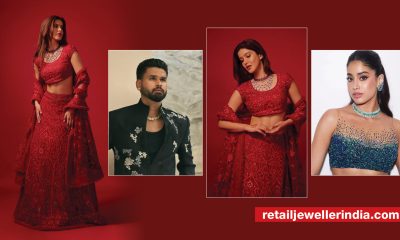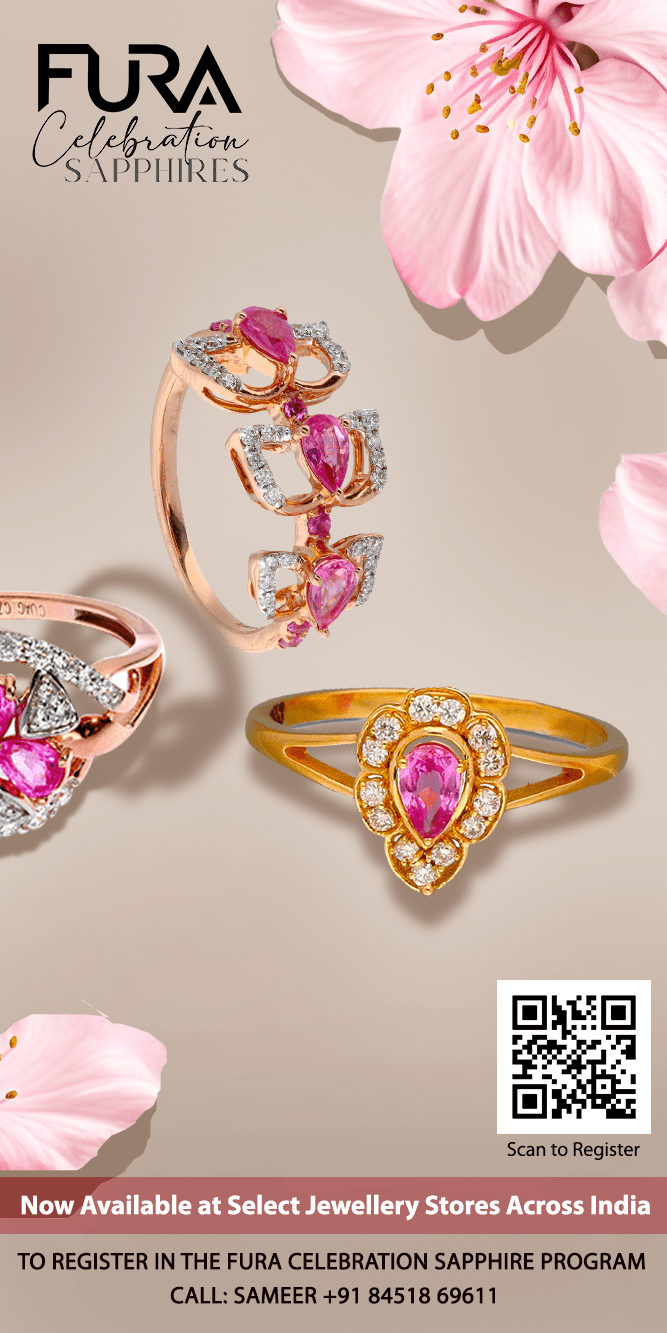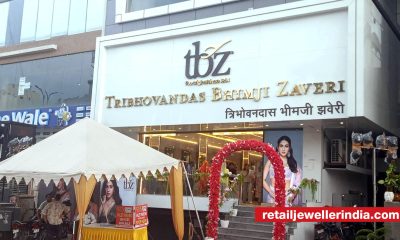RJ Market Watch
Post-Covid designing becomes a ‘force majeure’ in the jewellery sector

Jewellery is a luxury buy, but a secure investment too. With fluctuating markets and a drop in customer interests, thanks to the pandemic, the sector is looking at its lowest ebb. What was previously appreciated for grandiosity is now a matter of ‘too much’. In such a time, jewellery designs also need to change with the capricious minds of buyers and become more sustainable and nature friendly. Designers across the country are working towards more functional and multi-use designs to keep up the morale, for both customers and retailers.
For it to really play its role, designers are working hard to understand the consumers’ attitudes and perspective towards buying jewellery post Covid. It’s precarious. With low capital flow, no physical exhibition and shows to get feedback, and all-virtual modes, more work and time need to be put into understanding the customer, the market and its variations. “New habits, new essentials, new thoughts, the new normal and new events, all lead to a new place for design and innovation play. Some people are looking towards science, and some inwards — towards the science of the soul,” says Pallavi Dudeja Foley, founder of Pallavi Foley Boutique Jewels.
Design Insights
Take De Beers, for instance. They conducted a survey for an in-depth look into their diamond-buying strength. What they found: With buying capacity slashed to a borderline, most people are now looking to go for fewer, but better things. More people are looking for stones that are one-of-a-kind. Increased time in confinement has also made people appreciate the forces of nature, so sustainable and organic designs that can stand the test of time are the order of the day.
There is a growing sense amongst the designer community that the term ‘luxury’ itself will be redefined and now, it will be associated with exquisite pieces rather than expensive or branded imagery. “Even the younger generation will look into investing, especially in jewellery as an asset rather than buying designer bags or apparel,” said Shruti Jain, creative director of Nish Jewels.
Most designers are adapting themselves to customer sensibilities. The designs are being thoughtfully assembled to be optimally worn in more than one way or mixed with each other, besides being ‘stand out pieces’ in their own right. “With less capital to work with, it is an excellent time to give room to one’s innovations and experiments,” feels designer Neha Goyal of Itee.
Exploring Design Themes
“In a post-Covid world, the core offering must have a deeper meaning. Design trends represent the need for beauty to hope for a better future, caring for the environment and taking inspiration from traditions,” said Federica Imperiali, head of new product development at Forevermark. For the autumn-winter collections, Forevermark is looking at the idea of contemporary spirituality marked by qualities such as courage, love and creativity, all important at such a time, to be channelized through their La Suerte collection. The second trend is glorifying the styles of the past with a tinge of modernity. It will be brought out through their Royal 2.0 line. All designs are revolutionized to suit the current trends.
Foley Dudeja is looking at four strong trends. First – nature, she feels, will become a part of design stories for two reasons. “Being confined to our homes has deprived us from experiencing nature. A realization has crept in on how humans are exploiting it and how we need to preserve it. Flowers, for instance, have an instantaneous impact on our happiness, and is thus a theme worth exploring,” she says.
Second –restrictions on travel are also leading people to reminiscence about their past journeys. “Over time, people appreciate and hold souvenirs dear. We are trying to replicate them in our design forms,” she added.
Third – alternate healing and holistic living approaches are becoming popular. “Our collection of angels, inspired by arch angels saw a new popularity. The ‘Wear Your Prayer’ collection, which has 19 different world prayers engraved on them in a miniature gold egg, gained huge momentum in sales and queries, as communities chant the mantras for the collective well-being of the universe,” she said.
Lastly, sustainability and ethical sourcing will take up new meaning. “It’s not just for the end customer, but each one in the chain of production and our planet will benefit from it. Companies that only think profits and not sustainability will lose.
Designers believe there will be greater appreciation for natural materials. “There will be greater acceptance of handmade as opposed to machine made pieces. Consumers will positively enjoy flaws in materials and objects,” believes Goyal. ‘The raw finish of metals, raw diamonds will appeal more and more honestly reflect our flawed lives and current partial powers.’
Designers also believe that designs that enhance and portray local handicrafts and its intricate artisanship will be the new bandwagon. “We are articulating the lost touch of Indian craftsmanship like theva and pottery in our upcoming collections. Adding rare gemstones which is hard to be plagiarised will become an integral part of our designs,” says Jain.
The overarching belief is that any purchase post-Covid will be an emotional one; every piece of jewellery will hold a sentimental value. Therefore, spiritual name, initials of loved ones, and hope charms will be go-to pieces for clients,” says Goyal.
New Bridal Essentials
Weddings, a mega-earner for the sector, have either been postponed or cancelled. Even with the few that are taking the plunge, design has become a new segment to focus on. With the budget that previously entailed guests and fancy venues being slashed, focus on buying functional jewellery has increased. With lesser to plan and coordinate, brides have more time to focus on themselves and their look on the special day.
Brides are investing a lot of time in discovering designs online. “Trend research by young brides is slowly becoming popular,” says Foley Dudeja. She is observant of how brides-to-be are working hard to put the complete look together and physical distancing is not stopping them from investing time and patience.
“Recently, a bride-to-be got a luxury bridal fashion designer online with me, so that we could create the look together for her wedding ensemble. Three of us were in three different cities.” Meetings and collaboration today are breaking geographical boundaries like never before and that’s a fantastic outcome and realisation to take forward.
The other upshot of reduced scale of celebrations is more frequent ones. There will be Mehendi, haldi, music nights, intimate family dinners, house cocktails and other similar celebrated moments. These occasions will demand the bride and groom to be bejewelled,” says Vimal Kumar, design head of C Krishniah Chetty group.
“In this socially distanced era, friends and families would like to bless the newlyweds through video calls which demand them to be dressed up and bejewelled for these conversations,” feels Kumar.
Consumers are also going trendy by accessorizing their attires with masks and gloves that match their look. So, C Krishniah Chetty Group is bejewelling essential safety gear with some bling to boot. Designers see huge opportunity emerging from these occasions. “Every little ceremony can be targeted, even offering a package of all wedding-ceremony gifts can be a good strategy for the customers. Capturing all “mini-monies”, for miniature ceremonies, is the goal. We are designing according to the small and personal functions that are happening now,” said Goyal. Consequently, brides are opting for pieces that can be worn more than just one time.
“Transformable and detachable pieces for regular use and also, heritage pieces will continue to be popular even in 2021,” said Imperiali.
Brides will appreciate antique heritage jewellery even more now. In a world where people are valuing relationships and family, heirloom pieces may hold special significance. “Refurbishing their grandma’s jewellery with a modern aesthetic look will be in trend. Heirloom pieces will be preferred to be worn on wedding day,” Jain.
To remind consumers of their traditions and culture, designers are exploring different product options. “Mangalsutra like necklace called Tilhari from Nepal, or a simple Hastli necklace can be used to remind consumers of their roots,” says Shah.
Design Matters
Due to the pandemic, the luxury category will demand and move towards a new shift and individuals, even Gen Z, will look into investing, especially in jewellery as assets.
In a nutshell, every piece of jewellery will hold deeper meaning and more sentimental value.
In keeping with the new mediums of viewing designs, there is renewed focus on digital presentations. “As digitization and technology are the backbones in this delicate environment, we are infusing state-of-the-art technology which allows them to see what their pieces will look like finally,” said Kumar.
Virtual leaps are important, but personalization and uniqueness of design is what customers will value. While buyers will be compelled by history, traditions, customs and habits of a society, modern tweaks to make the pieces more wearable, multi-functional and strong enough to last as heirlooms will be the design go-to tactic in the future.

Courtesy: As published in The Retail Jeweller India magazine

 Personal Opinion2 weeks ago
Personal Opinion2 weeks agoBuy-back on gemstones to be on par with gold; A fear of return on the investment, more among high-end clients: Ankur Anand, Harsahaimal Shiamalal Jewellers

 Maverick Greenhorn1 month ago
Maverick Greenhorn1 month agoSegmenting retail approach to boost business performance

 Exclusive4 weeks ago
Exclusive4 weeks agoPrasad Jewellers’ Gold Bar Challenge fulfils multi-channel engagement goals, attracts young customers

 Daily News2 weeks ago
Daily News2 weeks agoTBZ – The Original launches its first store in Jaipur





























